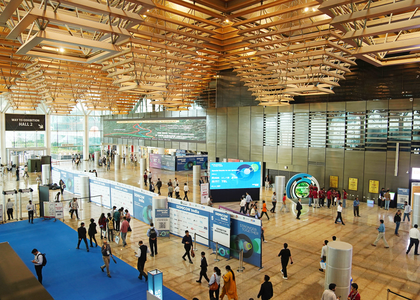SEMICON India 2025 bolsters India's vision to be a semiconductor leader: Report
By IANS | Updated: September 4, 2025 19:30 IST2025-09-04T19:28:51+5:302025-09-04T19:30:25+5:30
New Delhi, Sep 4 The SEMICON India 2025 concluded here on Wednesday, strengthening India's bid to become a ...

SEMICON India 2025 bolsters India's vision to be a semiconductor leader: Report
New Delhi, Sep 4 The SEMICON India 2025 concluded here on Wednesday, strengthening India's bid to become a global semiconductor leader through strategic partnerships with global companies, a report said.
The event, which was the largest of its kind, attracted over 350 exhibitors from 33 countries and more than 15,000 visitors, a report from India Narrative said.
The event, themed "Building the Next Semiconductor Powerhouse", highlighted India’s swift advancements under the India Semiconductor Mission (ISM), which has committed nearly 65,000 crore so far, the report said.
Further, the event, organised jointly by the ISM and global semiconductor industry association SEMI, highlighted technological trends and promoted collaboration across the supply chain.
Semiconductor equipment manufacturer ASML Holding NV, a global leader in semiconductor lithography, announced its intention to strengthen its partnership with Indian businesses in the upcoming year.
The ISM was launched in 2021 with a Production Linked Incentive (PLI) scheme worth Rs 76,000 crore to boost domestic manufacturing and design in the semiconductor sector.
Approved projects total 1.60 lakh crore, including Tata Electronics’ Rs 91,000 crore fab unit in Dholera, Micron’s Rs 22,516 crore packaging facility in Sanand, and CG Power’s new OSAT pilot line that started operations in August.
India is moving beyond traditional silicon-based semiconductors to Silicon Carbide (SiC)—more robust and heat-resistant (up to 2,400 degrees Celsius), ideal for defence and space applications, the report said.
On the design front, India is progressing towards 3D glass packaging for higher-performance chips.
The event featured a 'Workforce Development Pavilion' targeting a 1 million skilled worker goal by 2030 and a SEMI University Programme offering over 800 technical and business training courses.
Further, it featured a 'Design Startup Pavilion' showcasing indigenous chip design innovation.
The event highlighted investment pledges, workforce development, green manufacturing, and indigenous design. India has trained 60,000 students and produced 20 chips through local institutions, shifting from consumer to creator in the global chip economy.
As Taiwan, South Korea, Japan, China, and the US dominate chip production, their concentration creates supply chain risks, which India seeks to mitigate.
India’s semiconductor market stood at $38 billion in 2023 and is expected to hit $45 to $50 billion in 2024–25 and $100 to $110 billion by 2030. Globally, the semiconductor market is projected to grow to $1 trillion by the same year.
Disclaimer: This post has been auto-published from an agency feed without any modifications to the text and has not been reviewed by an editor
Open in app